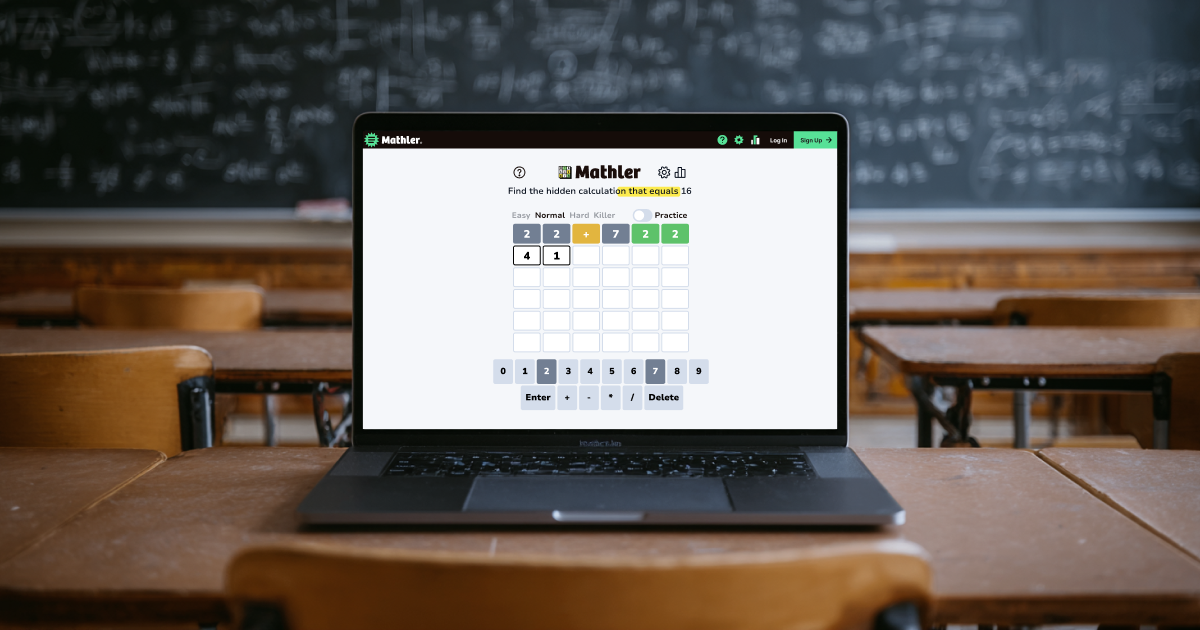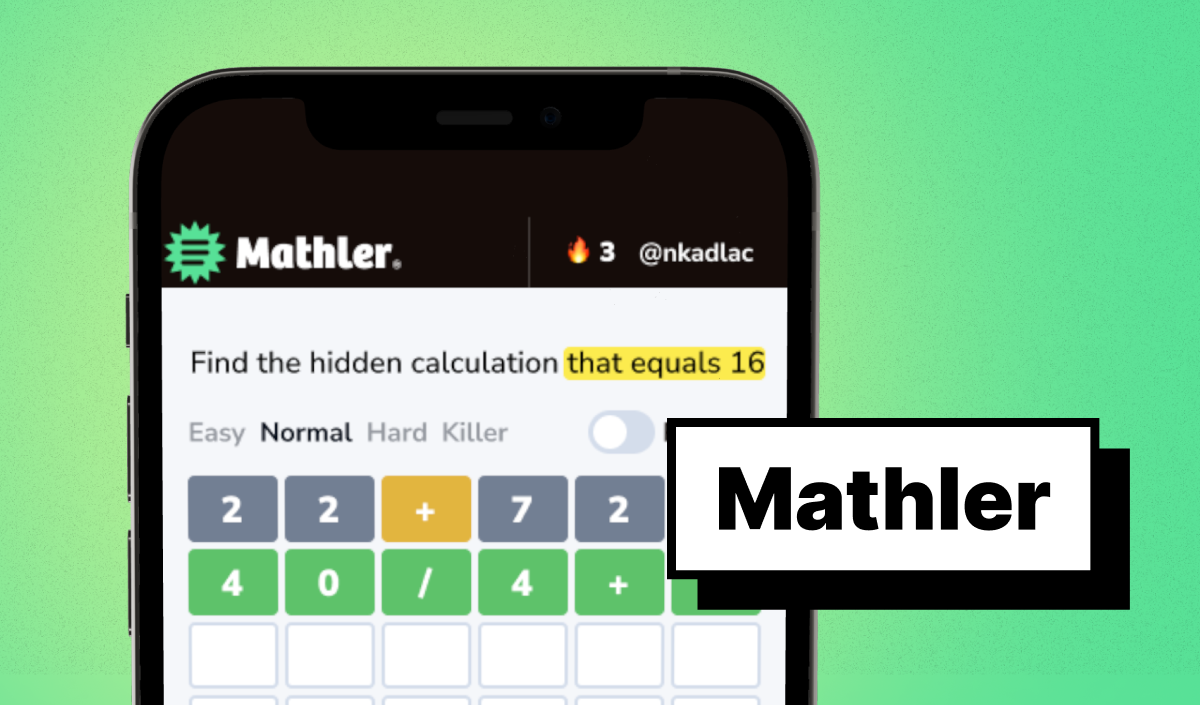Math Puzzles for Classrooms: 5-Minute Warm-Ups, Printables, and Lesson Ideas

Different innovations in creating interactive classroom activities have always been a primary focus of learning institutions all around the world, especially during the crucial development years of young students. After all, it's a fact that when students are interested and engaged in the topic at hand, they retain knowledge and good practices longer and stronger.
So what better way to make learning math fun than to use puzzle games?
Math puzzles are on the rise as learning tools, and Mathler is one of the best to use in a classroom setting for many reasons. Continue reading to learn more about how to turn fun math puzzles into knowledge-boosting brain teasers!
Quick Links
Why use math puzzles
5-minute routine
Grade-band guide
Classroom concerns
FAQ
Why use math puzzles in class?
- Short, high-yield practice: 3–5 minute solves improve number sense, mental math, and error analysis.
- Low prep: Launch instantly on web; no deck building or manipulatives required.
- Built-in motivation: Streaks, color feedback, and shareable results raise engagement.
- Curricular alignment: Natural practice of PEMDAS, factors/divisibility, and reasoning.
Right from the start, we have to say out loud what most young students think and say; "Math looks so boring and hard." This mentality, if not addressed early and overcome with effective teaching techniques and confidence-building, will eventually turn into aversion and ultimately lead to resentment of the subject.
And with the advancement of technology and ease of access to it, learning curricula must also adapt at the same pace. In the past, learning math with visual aids like flash cards and color-coded objects made the subject more approachable to impressionable young minds.
But in the current age, where even toddlers are being given access to mobile devices (which are now filled with media known to reduce attention span), different teaching methods must be used to draw them in and engage them long enough for them to learn something.
Online math games and logic puzzles are now a great way to promote learning in a classroom setting for the following reasons:
- They help them build number sense, sharpen mental arithmetic and error analysis in short bursts.
- Why short bursts? The modern human being's (not just children's) attention span has shrunk in the last decade. Short bursts of engagement now work better in garnering attention and retaining information.
- Online math puzzles are so much easier to prepare than the old ways of using presentations and other visual aids.
- Math games like Mathler allow students to naturally learn arithmetic and the order of operations (PEMDAS), as they are driven to win and earn positive validation from the instructor and their classmates.
- Continuous play of educational games builds not just confidence, but also the excitement of going to school. That excitement builds a way towards a routine, and the routine turns into practice.
Math logic puzzles: 5-minute brain teasers/exercises

Need a quick strategy for your class? Try these two quick step-by-step plans:
Projector/Share screen solving
- Solve today's Mathler puzzle, either the Easy or Normal/Classic difficulty levels.
- Project today's Mathler puzzle, but don't show the ones you solved. You can project a fresh daily puzzle by using incognito mode on your device or using another browser. Set a silent five-minute timer.
- Have the students prepare to solve individually with their own phones/devices, start the timer once everybody's ready, then stop them once the time limit is reached.
- Tally those who successfully completed the puzzle, then start debriefing and showing the process of solving it.
- For post-exercise engagement, ask students who won on their mental and problem-solving process.
Hands-on e-book page copies
- Get the free Mathler e-book, pick a page. Copy that page and solve it on your own or use the answer key.
- Prepare copies of that same page to hand out to the class. If you have a limited budget for copies, then halve the copies and pair the students up.
- Set a silent timer for five minutes. Start the timer once everybody's ready and have them stop once the time limit is reached.
- Show the correct answer on the board and tally those who successfully solved the puzzle. The process of how they all arrived at the right answer can be different, as long as they didn't go beyond the allotted tries of the puzzle.
- For post-exercise engagement, ask students who won on their mental and problem-solving process.
Level guide for student age groups
Grades 3–5
- Focus on addition/subtraction, simple multiplication and placing integers.
- Use Practice Mode, Easy difficulty if you plan to regularly drill them.
- Your main goal is to have them be comfortable in trying and making mistakes for them to learn.
Grades 6–8
- Focus on PEMDAS, factors/multiples, the use of parentheses and integer reasoning.
- Use Daily Mode, Classic or Hard difficulty for constantly changing daily refreshers.
- Your main goal is to increase their confidence in mental math and solidify the rules of operations in their minds.
Grades 9–12
- Focus on the structure of expressions, reasoning and proof and finally, efficiency.
- Since they are older kids, having stakes is needed to induce thrill and excitement for the exercise.
- Use Daily Mode, Hard or Killer difficulty for more challenging daily runs.
- Your main goal is to teach them solving efficiency, help them form their own strategies in solving tricky or complex expressions and eventually prepare them for an in-class friendly competition.
Common concerns in using device-based learning in a classroom setting
As an educator, you have to accept that there will be times when some students will be uncooperative with these exercises and that there will be problems at times, such as:
Unwillingness to join
The most common conundrum in a classroom setting. Right now, accept that there will truly be students uninterested in joining the activity and make peace with it. However, most of the time, students will always join if there is an incentive for them to do so.
Here are some ways to encourage students to try and join the math riddles/puzzles:
- Offer additional marks for reaching certain milestones in the activities, like students winning straight for two weeks, or solving an x number of puzzles correctly.
- Offer a little extra credit for mathematically-struggling students who are consistently trying to improve and joining the activities.
Cheating
A common problem with using a readily available online tool is that people can just prepare beforehand for the activity. Frankly, there would be no way to completely stop cheating outside of the classroom (like solving the puzzle on incognito mode or on a different account or device, having others solve it for them before class, looking up answers online, etc.)
However, it's important to remember that these exercises are for them to improve their math skills in the first place. If students are willingly solving the puzzles using their own time and not in class, isn't that already a win?
As for those who are solving the puzzles without actual effort, if you suspect them or a group of doing so, set them aside after class and casually approach them. Have them all solve several Practice Mode puzzles while you observe them carefully. You can confirm that they were cheating if:
- They cannot explain their logical reasoning for their process verbally, in writing or by directly showing their gameplay.
- They avoid the issue entirely.
- They cannot solve puzzles of lower difficulty than the ones they were apparently solving.
Colorblind students
Fortunately, most puzzle games nowadays have accessibility features built in, and the same goes for Mathler. If there are students who are having trouble discerning the color-feedback system, have them register for an account and toggle their colorblind mode in their settings.
Disinterest after continued failures
This is actually a prime opportunity to build rapport with a mathematically-struggling student. If they got disinterested after failing so much, then there is an underlying interest in the subject that must be nurtured and encouraged.
You can use this general guide for solving or provide personal insight on where they can improve.
FAQ
Is Mathler like Wordle?
Technically, it's a "math Wordle"—it uses a color-feedback system, and its logical system is similar.
Do students need accounts?
Not at all! They can start solving right away, no sign-up needed.
How long should the exercise take?
The average Mathler puzzle gets solved in three to five minutes.
Can I print puzzles?
Of course! We highly recommend our free e-book for classroom settings.
What grades is this for?
Mathler puzzles are great for students in the 3rd grade up to the 12th grade. Just don't forget to tweak settings relative to their age groups.
Does PEMDAS matter?
Very much so. The game won't even accept a bad entry and will prompt accordingly.
Can I embed it on my LMS page?
We'd be honored. Use the iframe snippet to embed it on your LMS.
Solve math riddles with your students today!
We hope that our Mathler classroom guide was able to help you find a way to integrate our puzzle into your curriculum! If you want more educational games you can use for teaching, then our website is something you need to visit!
You can also join our Discord server and share how it went when you introduced the game to your class. We'll be proud to feature your feedback and photos/videos in our newsletter if you send them!